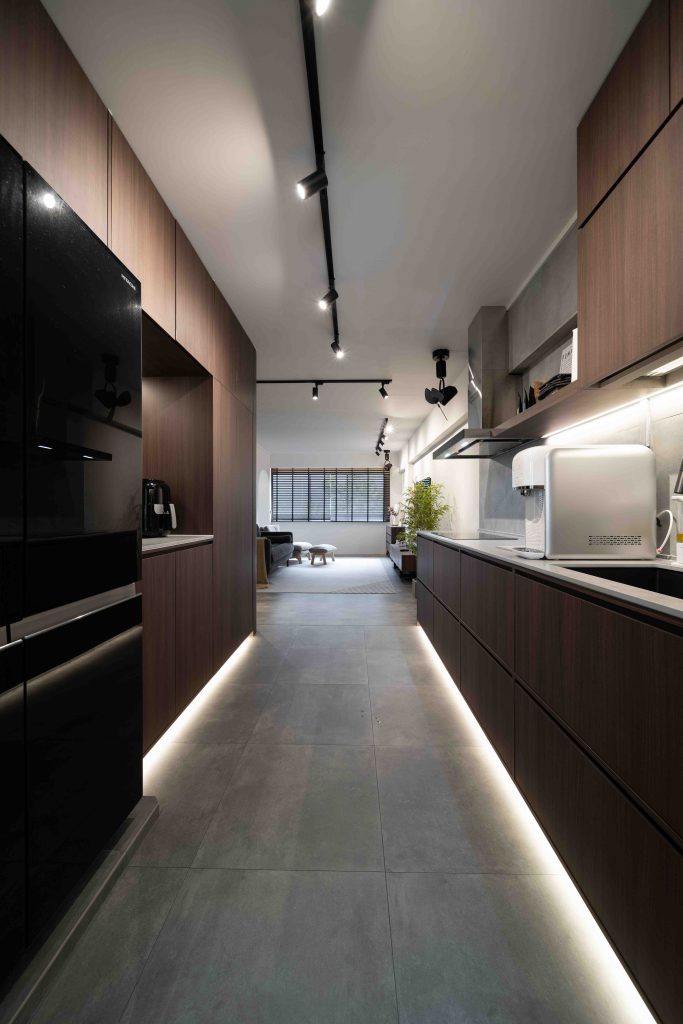Step into a world where design meets ancient wisdom, where harmony and balance reign supreme. Welcome to the realm of Feng Shui, an age-old Chinese philosophy that has captivated the hearts of interior designers and homeowners alike. In our quest to create living spaces that go beyond mere aesthetics, we discover the profound importance of cultivating balance and positive energy.
This article delves into the art of applying Feng Shui principles in interior design, unraveling the secrets of how space arrangement, color choices, and natural elements can transform our homes into havens of serenity and well-being. Get ready to embark on a journey where the flow of energy harmonizes with our surroundings, igniting a sense of tranquility and harmony in our everyday lives.
What should we know about the basics of Feng Shui?
Feng Shui, an ancient Chinese art and science, provides insights into how the arrangement of our living spaces can influence the flow of energy and impact various aspects of our lives. To harness the power of Feng Shui, it is crucial to understand the five elements and their interactions:
- Wood: Symbolizing growth, vitality, and flexibility, wood energy encourages new beginnings and fosters creativity.
- Fire: Representing passion, transformation, and high energy, fire energy fuels motivation and sparks inspiration.
- Earth: Embodies stability, grounding, and nourishment, earth energy provides a sense of security and fosters a solid foundation.
- Metal: Signifying clarity, precision, and focus, metal energy supports mental sharpness and promotes efficiency.
- Water: Reflecting adaptability, flow, and purification, water energy encourages emotional balance and invites abundance.
The concept of Yin and Yang is another fundamental aspect of Feng Shui. The interplay of Yin and Yang energies is vital for achieving balance and harmony:
- Yin: Associated with the feminine, introspective, and passive energy, Yin represents tranquility, receptivity, and relaxation.
- Yang: Embodied by the masculine, active, and outwardly oriented energy, Yang symbolizes vitality, assertiveness, and productivity.
Achieving a harmonious balance between Yin and Yang energies is essential for overall well-being. It involves considering factors such as lighting, color schemes, and furniture placement in our living spaces, creating an environment that supports both relaxation and productivity.

The Bagua, an eight-sided map, serves as a tool to understand the different areas of life and their corresponding elements within a space:
- Wealth and Prosperity: Associated with the Wood element, this area relates to abundance, prosperity, and material well-being.
- Fame and Reputation: Aligned with the Fire element, this area pertains to recognition, reputation, and personal achievements.
- Love and Relationships: Governed by the Earth element, this area focuses on harmonious partnerships, love, and emotional connections.
- Family and Health: Connected to the Wood element, this area relates to family relationships, health, and overall well-being.
- Creativity and Children: Aligned with the Metal element, this area centers around artistic expression, fertility, and nurturing relationships with children.
- Knowledge and Wisdom: Associated with the Earth element, this area pertains to personal growth, education, and wisdom.
- Career and Life Path: Governed by the Water element, this area focuses on professional growth, career success, and life purpose.
- Helpful People and Travel: Connected to the Metal element, this area relates to supportive relationships, mentors, and opportunities for travel.
How to Apply Feng Shui Principles in Specific Areas of the Home?
Applying Feng Shui principles to our living spaces can have a profound impact on our well-being and overall harmony. By understanding how to optimize the energy flow in specific areas of our home, we can create spaces that support our intentions and enhance various aspects of our lives. Whether it’s the bedroom, kitchen, or home office, each area holds unique significance.
Entryway and Main Door
The entryway and main door of your home are key areas where you can apply Feng Shui principles to create a positive and harmonious atmosphere. To apply Feng Shui principles in the entryway and main door of your home, consider the following simple tips:
1) Importance of a welcoming and unobstructed entryway
- Clear any clutter or objects that block the path to your front door.
- Create a clean and tidy entryway to allow positive energy to flow smoothly into your home. This allows positive energy, known as chi, to flow smoothly into your home, creating a warm and inviting atmosphere for you and your guests.
- Make sure the entryway is well-lit and inviting, creating a warm and welcoming atmosphere for you and your guests.
2) Use of colors and materials to enhance positive energy flow
- Choose colors that evoke a sense of harmony and positivity for your entryway.
- Consider using colors that resonate with you, such as soft neutrals, warm earth tones, or vibrant hues that make you feel good.
- Incorporate natural materials like wood or stone, as they have grounding and nurturing properties that enhance the flow of positive energy.
- Incorporating mirrors in the entryway is another effective way to enhance positive energy. Mirrors can reflect light and create a sense of spaciousness, making the entryway feel more open and inviting. This helps the energy to circulate freely and creates a harmonious atmosphere.

Furniture Placement and Room Layout
To apply Feng Shui principles in specific areas of your home, follow these simple tips for furniture placement and room layout:
1) Arranging furniture to facilitate a smooth flow of energy (Qi)
- Ensure there is enough space for energy to circulate freely in each room.
- Avoid placing furniture in a way that obstructs natural pathways or creates cramped areas.
- Allow energy to move smoothly by arranging furniture to create an open and inviting flow.
2) Creating a balanced and harmonious arrangement in each room
- Consider the size, shape, and function of the space when arranging furniture.
- Aim for symmetry and proportion in furniture placement.
- Arrange furniture to promote comfort, functionality, and a sense of balance in the room.
3) Avoiding clutter and maintaining clean and organized spaces
- Keep surfaces clear and decluttered to allow energy to flow freely.
- Regularly clean and organize your spaces to maintain a harmonious environment.
- Create storage solutions to keep belongings organized and out of sight.
Colors and Materials
When applying Feng Shui principles in specific areas of your home, consider these simple tips for colors and materials:
1) Choosing colors that correspond to specific elements for each area of the Bagua
- Identify the specific areas of the Bagua in your home, such as wealth, love, or career.
- Select colors that align with the corresponding element for each area. For example, use shades of green or brown for the wealth area, representing the Wood element.
- Incorporate these colors through paint, furnishings, or decor to enhance the energy in each specific aspect of your life.
2) Incorporating natural and sustainable materials
- Opt for natural materials like wood, stone, or bamboo in your home interior design and furnishings. These materials bring a sense of grounding and connection with nature, promoting a harmonious atmosphere.
- Consider using sustainable materials to align with eco-friendly principles and create a positive impact on the environment.
Lighting and Natural Light
To apply Feng Shui principles in specific areas of your home, consider the following tips for lighting and natural light:
1) Utilizing proper lighting
- Choose soft and diffused lighting to create a warm and welcoming atmosphere.
- Avoid harsh or overly bright lighting that can make the space feel uncomfortable.
- Use a combination of different light sources, such as overhead lights, lamps, and candles, to create a balanced and layered lighting effect.
2) Maximizing natural light
- Keep windows unobstructed and clean to allow natural light to flow freely into your home.
- Use sheer curtains or blinds that can be easily adjusted to control the amount of light entering the space.
- Consider adding reflective surfaces, such as mirrors or glass, to amplify the natural light and create a brighter and more expansive feel.
Incorporating Nature and Natural Elements
To apply Feng Shui principles in specific areas of your home, consider the following simple tips for incorporating nature and elements of nature:
1) Bringing indoor plants to improve air quality and create a calming environment
- Choose indoor plants that are suitable for the lighting and humidity conditions of your space.
- Position plants strategically in areas that require more vitality and freshness, such as the living room or home office.
- Indoor plants not only enhance the aesthetics but also purify the air and create a soothing ambiance, promoting a sense of calm and well-being.
2) Using natural elements like water features, rocks, and crystals to promote balance and tranquility
- Incorporate water features, such as a small fountain or aquarium, to bring the element of water into your space.
- Place rocks or crystals strategically to create a grounding and balanced energy in specific areas.
- These natural elements contribute to a sense of harmony and tranquility, enhancing the overall energy flow and promoting a calm and peaceful atmosphere.
Personal Spaces and Bedroom Design
To apply Feng Shui principles in your personal spaces, particularly in the bedroom, consider the following simple tips:
1) Creating a serene and relaxing bedroom environment
- Choose calming colors for your bedroom, such as soft neutrals or cool pastels, to promote a sense of serenity and relaxation.
- Keep the bedroom free from clutter and maintain a clean and organized space to create a peaceful atmosphere.
- Incorporate elements of nature, such as indoor plants or natural materials, to bring a sense of harmony and tranquility into your personal space.
2) Positioning the bed for optimal rest and energy flow
- Place your bed against a solid wall for stability and support, ensuring a sense of security.
- Avoid positioning the bed directly in line with the door, as it may disrupt the flow of energy and affect your quality of sleep.
- Consider placing a headboard behind the bed to provide a sense of grounding and stability.
We can conclude
It is not merely about arranging furniture or selecting colors; it is about embracing the essence of balance, harmony, and positive energy within our living spaces. Feng Shui teaches us that our homes can be sanctuaries where we find solace, inspiration, and rejuvenation.
By incorporating the timeless principles of Feng Shui, we tap into an ancient wisdom that resonates with our modern lives, enhancing our well-being and nurturing a profound connection with our surroundings.
So, let us embark on a journey where design and spirituality intertwine, and where every corner of our homes becomes a testament to the beauty of harmony and balance. Let Feng Shui guide us to create spaces that uplift our souls, inviting us to thrive in an environment that radiates serenity and positive energy.

Design your dream house with Exqsite
20 years of professionals experience
In Exqsite, our team of 20 years of professional experience will make your house beautiful and functional in every aspect, with an eye on detail and perfection. We guarantee you will be satisfied! Here are things that you will get from us:
- We provide high-quality workmanship at reasonable prices
- We put our clients first by serving them friendly customer service
- Employees with over 20 years of experience
Make your renovation situation easier with us. Click here or visit our showroom at 8 Boon Lay Way Tradehub21 #01-18 Singapore, Singapore 609964 for the solution to your renovation problems.
Frequently Asked Question
1) What is Feng Shui, and why is it important in interior design?
Answer: Feng Shui is an ancient Chinese philosophy that focuses on creating harmonious and balanced living spaces. It is essential in interior design because it promotes positive energy flow (Qi), which enhances well-being and overall quality of life.
2) How can I create balance and harmony in my home using Feng Shui principles?
Answer: Balance and harmony can be achieved by arranging furniture to facilitate a smooth flow of energy, incorporating colors and materials that correspond to specific elements, and keeping spaces clean and clutter-free. Paying attention to lighting, incorporating natural elements, and positioning personal spaces like the bedroom for optimal rest are also key aspects of creating balance and harmony.
3) Can Feng Shui principles be applied to specific areas of the home, such as the living room or kitchen?
Answer: Absolutely! Feng Shui principles can be applied to every area of the home. For example, in the living room, focus on creating a welcoming entryway, arranging furniture for optimal energy flow, and utilizing colors and materials that promote a positive atmosphere.
4) How does Feng Shui incorporate nature and natural elements into interior design?
Answer: Feng Shui places great importance on connecting with nature. This can be achieved by bringing in indoor plants for improved air quality and a calming environment.
5) Can I apply Feng Shui principles to my home office or workspace?
Answer: Absolutely! Feng Shui can be applied to your home office or workspace to enhance productivity, focus, and overall well-being.

